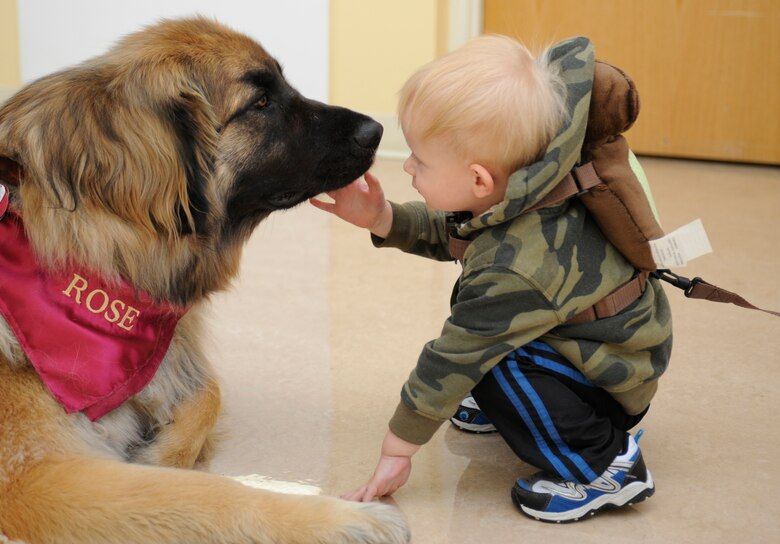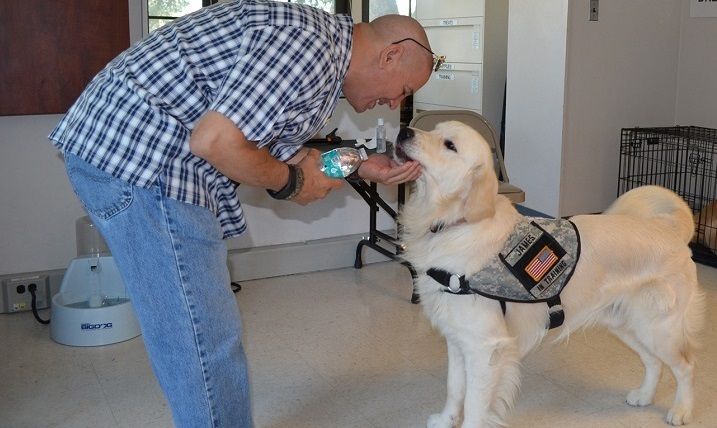Today, we’re going to talk about how to get your dog to be a therapy dog. We’ll discuss the training, certifications, and the entire process. We’ll also discuss what qualities your dog needs to be a great therapy dog.
There are differences between a therapy dog and a service dog, including not having as many privileges. To get your dog to be a therapy dog you need to have him registered with a national organization after completing the proper training.
Therapy dogs have become a popular solution to help brighten the spirits of people dealing with a difficult time. These dogs are often frequent visitors at hospitals, nursing homes, meetings with children, schools, and anywhere where a person might need companionship.
How to Get Your Dog to be a Therapy Dog?

Requirements to Register a Therapy Dog
Now that you know what a therapy dog does let’s look at how you can get your dog into this field. Before we cover the training, let’s talk about what characteristics a therapy dog needs.
Therapy Dog Temperament
Not all dogs will be able to work as a therapy dog. In addition to being obedient, therapy animals also need to have calm behavior and be over a year old. Dogs who are active and like to jump around might not be the best choice.
In addition to being calm and laid back, therapy animals also need to be affectionate and great with strangers. Part of the role of a therapy dog is to be hugged on and petted by the person they visit.
And they also have to be comfortable in unfamiliar settings. You will be taking your therapy dog to various locations. Your pet has to be good with random outings and different atmospheres.
Your therapy dog also needs to be up to date on all their vaccinations and in excellent health. Plus, you will need to have an excellent grooming routine to keep your dog clean and presentable.
Canine Good Citizen
Therapy animals also need to be obedient. Your dog will not qualify as a therapy dog if they don’t know how to follow commands. Most legitimate organizations will require an AKC Canine Good Citizen (CGC) certificate.
You can teach your dog the skills for the CGC test, or you could choose to enroll your pet in a professional obedience training program. Some people choose to enroll in a cognitive dog training course to learn how to handle their pets in a therapy situation.
The test consists of ten commands that your dog has to obey. These are:
- Accepting a stranger
- Allow petting
- Grooming and appearance
- Walking on a leash properly
- Interacting with a crowd
- Sit/down commands; staying in place
- Approach when called
- Interaction with other dogs
- Distractions
- Separation

Registering Your Therapy Dog
Assuming you have a mild-mannered, friendly pooch that loves to visit new places and interact with different people. In that case, you have the makings for a perfect therapy dog.
Once your pet has been appropriately vaccinated and trained, the next step is to find an organization to register your pet. There are a ton of different resources out there, so it’s not hard to find one in your area. You can choose a local organization or go with a more notable company.
Some of the best therapy dog organizations we recommend are:
- American Kennel Club (AKC)
- Therapy Dogs International (TDI)
- Pet Partners
- Alliance of Therapy Dogs (ATD)
- American Service Pets (ASP)
- Service Dog Certifications (SDC)
ESA (Emotional Support Animal) Letter
To be certified as a therapy dog, your pet does not need to go through specialized training. However, each organization has different qualifications for what is necessary for your pet to receive a certificate. In all cases, you will have to pay a fee to get your pet registered.
After your pet has passed his Canine Good Citizen test, the company will issue an ESA (Emotional Support Animal) letter. This certificate will give you the proper credentials to use your pet as a therapy dog in most locations.
Therapy dogs do not have the same privileges as emotional support animals or service animals. So, you cannot fly with them or have them in a home with a no-pet policy. They are considered a pet rather than an actual service animal.
To get involved in places that will let your pet work as a therapy dog, you will have to set up a meeting and request the privilege. Or apply at locations that are already in the market for such services. You cannot take your therapy dog into a place without an invitation or permission.

What is a Therapy Dog?
Throughout history, dogs have been man’s best friend, a loyal teammate. Their uncanny ability to sense when a person is emotionally upset makes them perfect for serving as therapy animals. Most dogs will respond to an upset person with licks, cuddles, and affection.
Research has proven that we find comfort in the silent support of a dog. These pets don’t ask questions or try to get you to talk about your problems. Instead, they stay by your side and show you love and attention.
Psychological Benefits
Petting a dog provides psychological benefits, such as helping to reduce stress and anxiety. Many people use therapy dogs as a soundboard for their problems.
No matter what you say to a dog, they won’t abandon you, making them perfect for confessing your worries and fears. Often, you can get clarity and peace of mind just by giving a voice to your distressing thoughts.
Research has also proven that spending time with a therapy dog can help reduce depression, boost positive thinking, and soothe fears.
Physical Benefits
There are also plenty of physical benefits to therapy dogs. Spending time with a therapy animal can help lower blood pressure and reduce physical discomfort.
Therapy dogs are also great at helping encourage people to get more exercise and can boost their energy levels. For autistic patients, therapy animals can help improve social interactions and language skills.
Final Verdict
Registering your pet as a therapy dog is a great way to allow your pet to share their natural compassion and caring spirit with those in need. Hospitals, nursing homes, schools, and some corporate facilities are typically open to allowing visits from registered therapy dogs.
However, remember that there are restrictions for therapy dogs that you might not face with other service animals. Restrictions such as not taking your pet inside a store or aboard flights, and there might be separate requirements for the organization you plan to visit.
If your pet has all the qualities we’ve mentioned, he or she might be perfect to work as a therapy dog. After getting your pet’s Canine Good Citizen certificate, do your research to find a company that works for your needs. Your final step is to pay your fee and get your pet registered.

Kassidy Shepperd is the editor in chief for Canine-Prime.com. She is is a dog lover/trainer, a freelance writer and a volunteer at many pet rescue and shelter centers. Kassidy is based in Colorado and regularly writes for dog related magazines and blogs.


